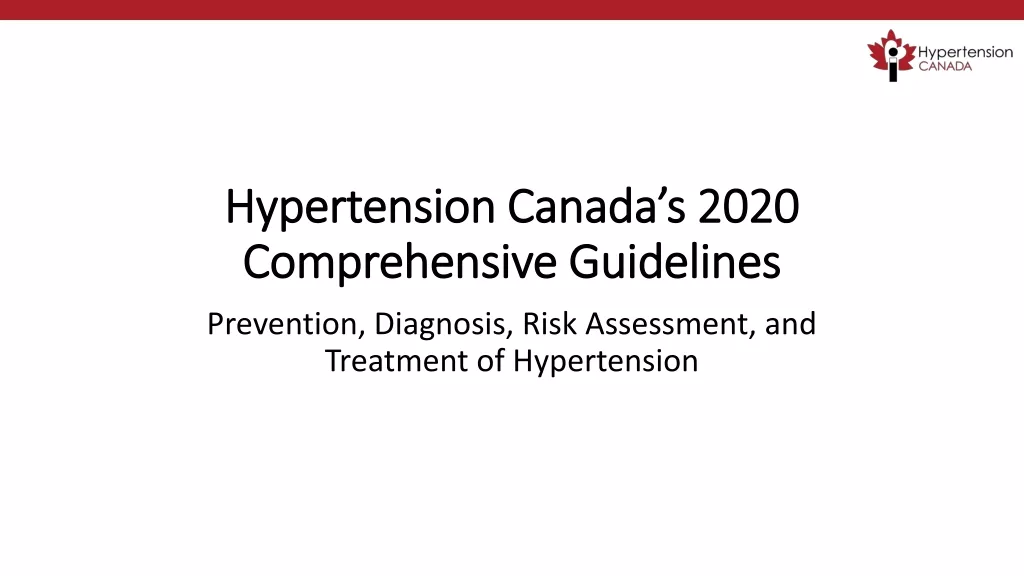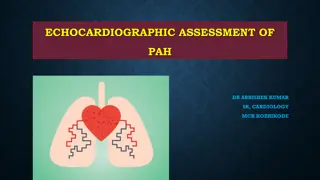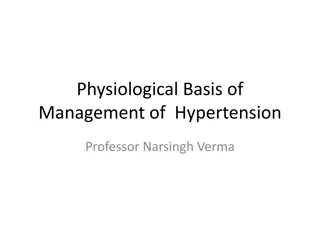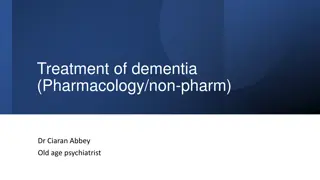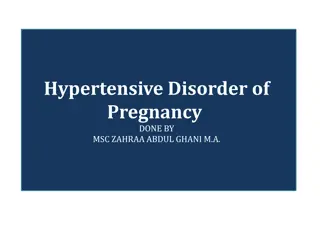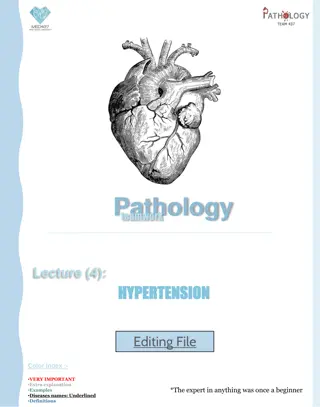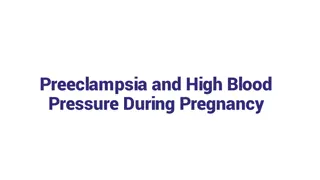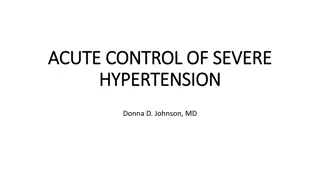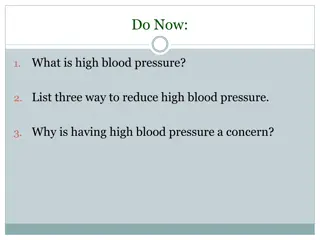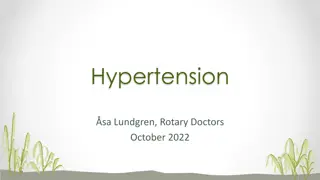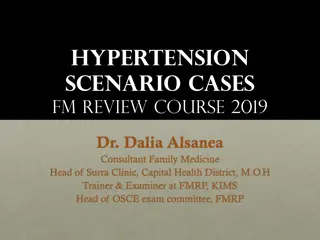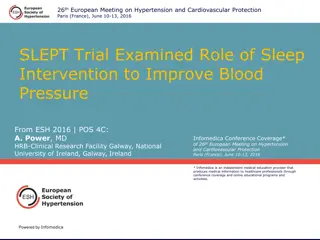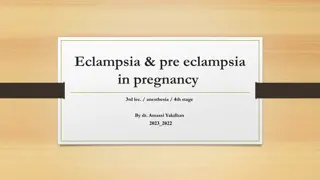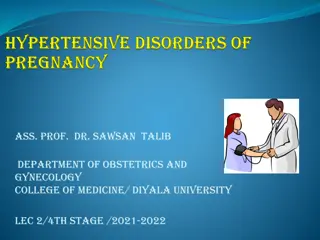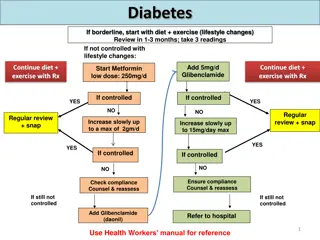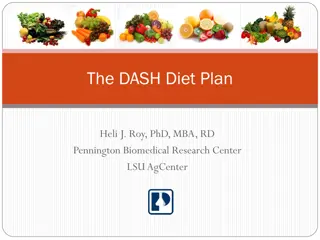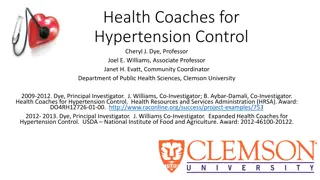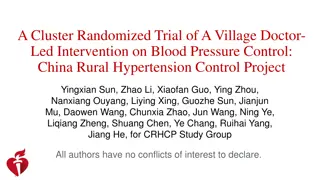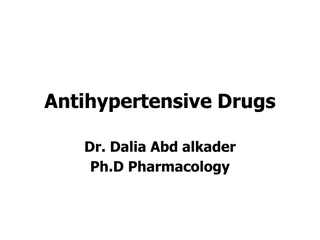Understanding Hypertension: A Comprehensive Overview
High blood pressure (BP) is considered a trait rather than a specific disease, with risks increasing with age. Antihypertensive therapy has shown to reduce the incidence of stroke and coronary artery disease. Managing hypertension effectively involves a holistic approach targeting modifiable risk factors. The definition of hypertension is when the benefits of treatment outweigh the costs. Regular BP checks are recommended every 5 years for adults.
Download Presentation

Please find below an Image/Link to download the presentation.
The content on the website is provided AS IS for your information and personal use only. It may not be sold, licensed, or shared on other websites without obtaining consent from the author. Download presentation by click this link. If you encounter any issues during the download, it is possible that the publisher has removed the file from their server.
E N D
Presentation Transcript
High BP is a trait as opposed to a specific disease and represents a quantitative rather than a qualitative deviation from the norm. Any definition of hypertension is therefore arbitrary.
Systemic BP rises with age, and the incidence of cardiovascular (particularly stroke and coronary artery disease) is closely related to average BP at all ages, even when BP readings are within the so-called normal range . disease
Randomised demonstrated that antihypertensive therapy can reduce the incidence of stroke and, to a lesser extent, coronary artery disease . controlled trials have
The cardiovascular risks associated with a given BP are dependent combination of risk factors in an individual, such as age, gender, weight, physical activity, smoking, family history, serum cholesterol, diabetes existing vascular disease. upon the mellitus and pre-
Effective requires a holistic approach, based on the identification of cardiovascular risk multifactorial interventions, targeting not only BP but all modifiable cardiovascular risk factors. management of hypertension those and at highest use the of
Thus a practical definition of hypertension is the level of BP at which the benefits of treatment outweigh the costs and hazards . The British Hypertension classification of hypertension is consistent with those defined by the European Society of Hypertension and the World Health Organization International Hypertension. Society Society of
Hypertension asymptomatic condition and the diagnosis is usually made at routine examination or when a complication arises. A BP check is advisable every 5 years in adults. is predominantly an
The objectives of the initial evaluation of a patient with high BP readings are: -to obtain accurate measurements of BP -to identify contributory factors and any underlying cause (secondary hypertension) - to assess other risk factors and quantify cardiovascular risk and representative
-to detect any complications (target organ damage) that are already present -to identify comorbidity that may influence the choice of antihypertensive therapy. These goals are attained by a careful history, clinical examination investigations. and some simple
The term syncope refers to sudden loss of consciousness due perfusion. Presyncope refers where the individual thinks he or she may black out. to reduced cerebral to lightheadedness
Syncope population at some time and accounts for more than 5% of hospital admissions. Dizziness and presyncope are very common in old age. Symptoms are disabling, confidence and independence, and can affect an individual s ability to work or to drive. affects around 20% of the undermine
There are several mechanisms that underlie recurrent presyncope or syncope: -cardiac syncope due to mechanical cardiac dysfunction or arrhythmia -neurocardiogenic syncope abnormal autonomic bradycardia and/or hypotension. in reflex which an causes
Blackouts can also be caused by non-cardiac pathology such as epilepsy, cerebrovascular ischaemia or hypoglycaemia.
History-taking, witness, diagnosis. Attention should be given to potential triggers (e.g. medication, exertion, posture), the victim s appearance (e.g. colour, seizure activity), the duration of the episode and the speed of recovery. from key the to patient establishing or a a is the
Cardiac syncope is usually sudden but can be associated lightheadedness, palpitation discomfort. The blackout is usually brief and recovery rapid. with premonitory or chest
Neurocardiogenic syncope will often be associated with a situational trigger, and the patient may experience flushing, nausea and malaise for several minutes afterwards. Patients with seizures do not exhibit pallor, may have abnormal movements, usually take more than 5 minutes to recover and are often confused.
A history of rotational vertigo is suggestive of a labyrinthine or vestibular disorder. The pattern and description of the patient s symptoms should indicate the probable mechanism and subsequent investigations. help to determine
Arrhythmia : Lightheadedness may occur with many arrhythmias, but blackouts (Stokes Adams attacks) are usually bradycardia or malignant tachyarrhythmias. due to profound ventricular
The 12-lead ECG may show evidence of conducting system bradycardia, AV block, bundle branch block or axis deviation) which would predispose a patient to bradycardia, but the key to establishing a diagnosis is to obtain an ECG recording during symptoms. disease (e.g. sinus
Since common, especially in old age, symptoms must occur at the same time as a recorded arrhythmia before a diagnosis can be made. Ambulatory ECG recordings are helpful only if symptoms occur several times per week. minor rhythm disturbances are
Patient activated ECG recorders are useful for examining the rhythm in patients with recurrent dizziness, but are not useful in assessing sudden blackouts.
In patients with presyncope or syncope in whom these investigations fail to establish a cause, an implantable loop recorder can be placed subcutaneously in the upper chest. This device continuously cardiac rhythm automatically if extreme bradycardia or tachycardia occurs. records will the and activate
The ECG memory can also be frozen by the patient using a hand-held activator. Stored ECGs can be accessed by the implanting centre, using a telemetry device.
Structural heart disease: Severe obstructive coronary lightheadedness or syncope on exertion. aortic stenosis, hypertrophic and can cardiomyopathy artery severe cause disease
This is caused by profound hypotension due to a fall in cardiac output, or failure to increase output during exertion, coupled with exercise-induced vasodilatation. Exertional arrhythmias also occur in these patients. peripheral
Neurocardiogenic syncope: This encompasses a family of syndromes in which bradycardia and/or hypotension occur because of a series of abnormal autonomic reflexes. The two main conditions are hypersensitive carotid sinus syndrome malignant vasovagal syncope. (HCSS) and
Situational syncope: This is the collective name given to some variants of neurocardiogenic syncope that occur in the presence of identifiable triggers (e.g. cough syncope, micturition syncope)
Vasovagal syncope: This is normally triggered by a reduction in venous return due to prolonged standing, excessive heat or a large meal. It is mediated by the Bezold Jarisch reflex, in which there is an initial sympathetic activation that leads to vigorous contraction of the relatively underfilled ventricles.
This mechanoreceptors, parasympathetic sympathetic bradycardia, vasodilatation or both. stimulates ventricular producing activation and (vagal) and withdrawal, causing
Head-up tilt-table testing is a provocation test used to establish the diagnosis, and involves asking the patient to lie on a table that is then tilted to an angle of 60 70 for up to 45 minutes, while the ECG and BP are monitored.
A positive test (cardio-inhibitory hypotension is characterised by bradycardia and/or response) associated with typical symptoms. Initial management modification (salt avoiding prolonged standing, dehydration or missing meals). response) (vasodepressor involves supplementation lifestyle and
In resistant cases, drug therapy can be used; fludrocortisone, which causes sodium and water retention and expands plasma volume, -blockers, which sympathetic activation, vagolytic agent) vasoconstrictor -adrenoceptor agonist) may be helpful. inhibit the initial disopyramide midodrine (a (a or
A dual-chamber pacemaker can be useful if symptoms are predominantly bradycardia. Patients with a urinary sodium excretion of less than 170 mmol/day may respond to salt loading. due to
Carotid sinus hypersensitivity: This causes presyncope or syncope because of reflex bradycardia and vasodilatation. Carotid baroreceptors are involved in BP regulation and are activated by increased BP, resulting in a vagal discharge that causes a compensatory drop in BP.
In HCSS the baroreceptor is sensitive to external pressure movement or if a tight collar is worn), so that pressure over the carotid artery causes an inappropriate discharge. (e.g. during neck and intense vagal
The monitoring the ECG and BP during carotid sinus massage for 6 seconds. This man uvre should not be attempted in patients with a carotid bruit or with a history of cerebrovascular disease because of the risk of embolic stroke. diagnosis can be established by
A positive cardio-inhibitory response is defined as a sinus pause of 3 seconds or more; a positive vasodepressor response is defined as a fall in systolic BP of more than 50 mmHg.
Carotid sinus pressure will produce positive findings in about 10% of elderly individuals but less than 25% of these experience spontaneous syncope. Symptoms should not therefore be attributed to HCSS unless they are reproduced by carotid sinus pressure.
Dual chamber pacing usually prevents syncope in patients with the more common cardio-inhibitory response.
Postural hypotension: This is caused by a failure of the normal compensatory mechanisms. Relative hypovolaemia excessive diuretic degeneration (diabetes mellitus, Parkinson s disease, ageing) (vasodilators, antidepressants) can all cause or aggravate the problem. (often due to therapy), sympathetic and drug therapy
Treatment is often ineffective; however, withdrawing unnecessary medication and advising the patient to wear graduated elastic stockings and get up slowly may be helpful. Fludrocortisone, which can expand blood volume through sodium and water retention, may be of value.
Palpitation is a very common and sometimes frightening symptom. Patients use the term to describe a wide variety of sensations including an unusually erratic, fast, slow or forceful heart beat, or even chest pain or breathlessness.
Initial evaluation should concentrate on determining its likely whether or not underlying heart disease. A detailed description of the sensation is essential and patients should be asked to tap out the heart beat they experience, on their chest or a table. mechanism, is and there significant


